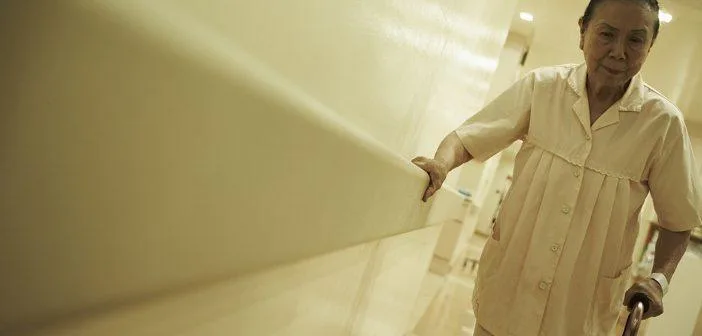Nurses at UC San Diego Health System have a new tool for falls prevention: portable remote video monitoring of patients at greatest risk. After a two-year pilot, Laura Vento, MSN, RN, CNL, interim nurse manager, and Paige Burtson, MSN, RN, NEA-BC, associate director of nursing medical surgical specialties, are convinced the remote monitoring improves safety for patients. [caption id="attachment_45588" align="alignright" width="247"] Laura Vento, RN[/caption] Vento and Burtson led the pilot study, starting in November 2012, using six video monitoring carts. After analyzing data, Burtson said the hospital is continuing with the program and adding two more carts. She said the study was a response to increases in sitter use "which almost tripled in a few years, but when we investigated fall rates, they were consistently the same, even with more sitters."
Laura Vento, RN[/caption] Vento and Burtson led the pilot study, starting in November 2012, using six video monitoring carts. After analyzing data, Burtson said the hospital is continuing with the program and adding two more carts. She said the study was a response to increases in sitter use "which almost tripled in a few years, but when we investigated fall rates, they were consistently the same, even with more sitters."
Pilot data
Data from the pilot demonstrated they could reduce sitter use and maintain or improve outcomes for falls or injuries, Burtson explained. "Overall rate of falls per 1,000 patient days ranged from 2.4-2.5 facility-wide" before the pilot. The second full year of implementation, the rate was 2.33 falls per 1,000 patient days. Additionally, Vento said "the monitoring increased nurses' awareness of what went on in patients' rooms when nurses weren't there. Nurses also have become more aware of the proximity of patients' personal items, call bell, urinals and bed alarms, making sure they are accessible. She said the video monitor techs provide nurses with insights into their patients after observing them through entire shifts. For example, the tech might hear a patient talking aloud about wanting to go home, leading to unsafe behaviors such as wandering. Aside from falls prevention and wandering, the monitoring is useful with patients who are in isolation, are violent or impulsive -- scenarios that put a sitter at risk, Burtson said.
Patient response to remote monitoring
One surprise, she said, was how responsive patients are to the two-way audio intervention. "We underestimated that. Patients who are moderately confused can often respond to the VMT asking them to stay in bed." Both Vento and Burtson said prior to the study, nurses feared their work flow would be negatively impacted by continual calls to respond to patient concerns. Instead, Vento said, "knowing their patients are safe has been a tremendous plus. It took time for the nurses to trust that this intervention works, and that the patients would respond to a voice when they can't see the caregiver." [caption id="attachment_45593" align="alignright" width="279"] Paige Burtson, RN[/caption] She said the program also promotes teamwork. If the VMT deems that the patient needs nursing intervention, the tech calls the nursing station and any available staff can intervene. Most patient privacy concerns have been allayed, Vento said, by having the VMT meet patients during shift changes or rounds, and by explaining that no recordings are made. In addition to hard data, the program's success is evidenced by the waiting list to use the eight carts, Burtson said. As one of many tools for improving patient safety, video monitoring is a valuable option. [accordions] [accordion title="How video monitoring works" load="hide"]The video monitoring pilot at UC San Diego Health System used portable carts, each with a camera on an IV-like pole. Connected to a secure wireless network, a cart is stationed in a patient's room to provide real-time video, explained Lisbeth Votruba, MSN, RN, PCCN, vice president of clinical quality and innovation at vendor AvaSure. Two-way audio is a significant element, Votruba said, allowing speaking between the trained video monitor technician and the patient. The VMT monitors the patients from a remote site, inside or even outside the building where patients are roomed. Typically the VMT is a nursing assistant, who has been trained to use the technology; a VMT can monitor 10 to 12 patients per shift. The effectiveness of the technology, Vento said, is that "there's an actual person behind the voice and the intervention. A real person is individualizing care and responding to the patient."[/accordion] [/accordions]
Paige Burtson, RN[/caption] She said the program also promotes teamwork. If the VMT deems that the patient needs nursing intervention, the tech calls the nursing station and any available staff can intervene. Most patient privacy concerns have been allayed, Vento said, by having the VMT meet patients during shift changes or rounds, and by explaining that no recordings are made. In addition to hard data, the program's success is evidenced by the waiting list to use the eight carts, Burtson said. As one of many tools for improving patient safety, video monitoring is a valuable option. [accordions] [accordion title="How video monitoring works" load="hide"]The video monitoring pilot at UC San Diego Health System used portable carts, each with a camera on an IV-like pole. Connected to a secure wireless network, a cart is stationed in a patient's room to provide real-time video, explained Lisbeth Votruba, MSN, RN, PCCN, vice president of clinical quality and innovation at vendor AvaSure. Two-way audio is a significant element, Votruba said, allowing speaking between the trained video monitor technician and the patient. The VMT monitors the patients from a remote site, inside or even outside the building where patients are roomed. Typically the VMT is a nursing assistant, who has been trained to use the technology; a VMT can monitor 10 to 12 patients per shift. The effectiveness of the technology, Vento said, is that "there's an actual person behind the voice and the intervention. A real person is individualizing care and responding to the patient."[/accordion] [/accordions]






